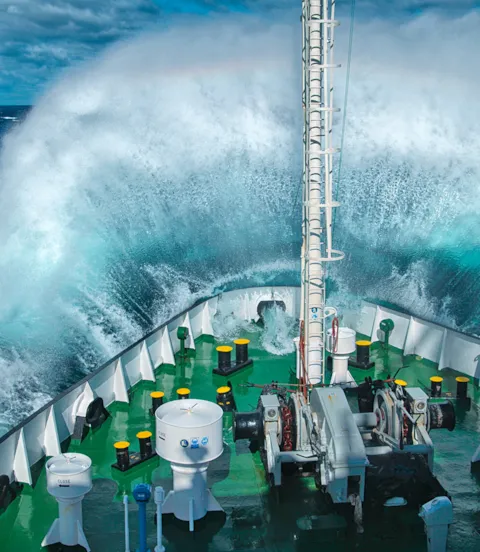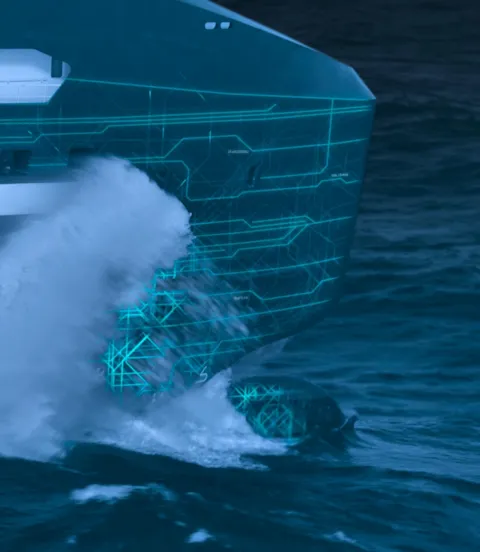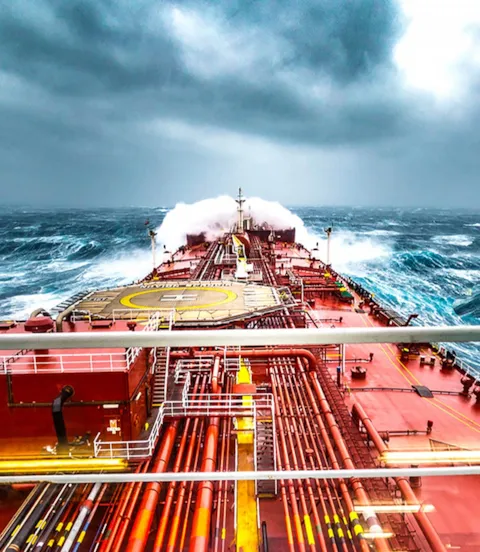Fleet-wide implementation of next-generation hull integrity monitoring
Working in collaboration with Altera Infrastructure, one of the world’s leading operators of shuttle tankers, DNV has successfully completed a fleet-wide implementation of “Nerves of Steel”, the industry’s most- advanced hull integrity monitoring system.
For decades, assumptions about the status of the structural integrity of a vessel have been based on its age, design and observations taken from surveys, which only provide a static snapshot of existing conditions. In the absence of more concrete, verified data, different stakeholders have been left to make critical decisions related to safety, scheduled maintenance, inspections, commercial operations, charter agreements and calculations on insurance premiums. Worse, the quality of these assumptions degrades as a vessel ages, leaving many to only estimate the real condition of a vessel’s structural integrity.

Nerves of Steel provides more precise decision support
According to Antonio Goncalves, Business Lead (Maritime Advisory) at DNV, the organization worked to develop a tool called “Nerves of Steel” that can provide a more dynamic overview, which not only helps explain past findings, but also allows owners to predict the future degradation of the vessel. “Simply by pairing a vessel’s location using AIS data with asset-specific information, we can calculate wave loads on the hull with far more accuracy,” he explains. “And by applying DNV’s hull integrity analytical expertise and other relevant data, we can provide owners and other stakeholders with better decision support.”
In addition to reducing safety risks, Nerves of Steel allows for more cost-effective and proactive scheduling of dry-dockings and provides greater guidance on where inspectors should focus to find potential damage, saving time at the yard. “Nerves of Steel is a user-friendly tool, providing operators with a high-level overview of the fleet, with hull integrity indicators based on encountered weather conditions,” says Goncalves. “This insight gives owners a better understanding of structural integrity.”

Utilizing new technologies to calculate operational effects
The development of increasingly sophisticated software tools, such as digital twins and onboard sensors now found on many vessels, created an opportunity to develop Nerves of Steel further. “For example, by utilizing ‘digital twins’ to calculate the wave-induced damage risk for ship hulls, fleet managers can visualize all key components, perform analyses and calculations,” explains Goncalves. “In this way, owners have more control over the long-term effects of operation on the ship’s structural and functional components.”
In 2020, DNV entered into a formal collaboration with Altera Infrastructure to develop a structural monitoring system for hulls that would add value to its fleet of shuttle tankers. According to Lars Holterud Aarsnes, DNV’s Digital Product Manager (Maritime Advisory), working with Altera Infrastructure provided invaluable insight. “By sharing their hands-on experience and operational know-how, Altera Infrastructure ensured the tool has the correct features and usability for the end user, “Aarsnes says. “DNV’s contribution was to perform the technical calculations and develop a dashboard to help users visualize hull utilization of individual vessels.”

Altera benefits from increased fleet safety
James Fowler, Structural Integrity Manager for Altera Infrastructure, says that while Nerves of Steel may focus on safety via hull integrity monitoring, the concept supports the company’s business objectives. “We have gained a great deal of insight working with DNV, and by identifying our safety, operational and commercial priorities which are unique to our shuttle tanker fleet, we have a solution that fits our needs,” he says. “We have implemented the basic Nerves of Steel indicator service across our entire shuttle tanker fleet and are currently pilot-testing the digital-twin numerical services on four vessels, which provides us with near real-time monitoring of hull integrity.”
Fowler notes that Nerves of Steel allows them to further establish proactive inspection and maintenance regimes to identify small defects before they become critical, which is crucial. “This is not just a matter of safety,” he says. “We have a high utilization rate across the fleet, so taking a vessel out of service to carry out unscheduled steel repairs is bad for business. And because demand for more detailed hull integrity assessments is increasing, Nerves of Steel helps to strengthen the confidence that charterers and insurers have in our organization. We are no longer working with assumptions but with verified data.”
“We have gained a great deal of insight working with DNV, and by identifying our safety, operational and commercial priorities, we have arrived at a solution that fits our needs.”

Visualizing potential vessel damage
One focus of the project was to develop a dashboard that enables Altera to visualize hull integrity in real time. “The dashboard has helped us gain a better understanding of the relationship between a vessel’s trading pattern, the weather and hull integrity,” says Fowler. “This allows us to evaluate the consequences of operating in harsh weather environments and at the same time gives us the foresight to make more informed decisions on routing. By potentially limiting our vessel’s exposure to high wave loads, we can quantitively extend the life of the asset for continued shuttle tanker operations, or select a suitable asset for further analysis for conversion.”
Nerves of Steel also provides data that helps Altera perform root-cause analysis. “In addition to gaining a better understanding of how structural defects may develop on a particular vessel, this hindsight can be applied to sister ships for comparison purposes; it also helps inform us how we should design vessels, especially those expected to operate in areas with challenging weather conditions, such as the North Sea,” he says. “What can be measured can be managed.”

Sensor technologies provide a clearer picture of hull structure
In addition to the basic Nerves of Steel service (indicators) and the digital-twin service (numerical), DNV has also developed a hybrid service which integrates data from on-board sensors. “Using relevant sensors, combined with numerical models and relevant weather data, we can provide an even more accurate picture of hull structure utilization,” says Goncalves. “And in cooperation with Altera Infrastructure, we are developing a reporting tool that makes it easier to share data and exploring how the application of machine-learning algorithms can strengthen the service.”

Findings and tools can be translated into other projects
Goncalves says that while this Nerves of Steel project was developed for Altera Infrastructure’s fleet, “lessons learned” from the collaboration have produced a proven suite of tools that can be easily applied to other shipping segments or offshore structures. “DNV is working with a broad range of stakeholders in the maritime and energy industries to enable owners to monitor their assets in real time through the Nerves of Steel interface,” he says. “We are confident that as more stakeholders become aware of the benefits of this approach, we will be able to enable safer, more cost-effective operations.”

- Altera Infrastructure
- The availability of more specific condition data based on dynamic load measurements enables better predictions of hull degradation.
